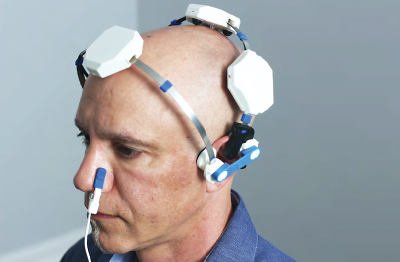The Department of Veterans Affairs (VA) is pioneering a treatment known as transcranial light-emitting diode (LED) therapy for veterans with persistent symptoms of traumatic brain injury (TBI).
The VA began treating veterans who have treatment-resistant TBI with LED therapy in Boston in November 2017. The clinic aims to treat TBI’s most common symptoms: sleep disturbance; cognitive impairment; and related neuropsychiatric symptoms, such as posttraumatic stress disorder (PTSD) and mood issues, said Yelena Bogdanova, Ph.D., a clinical neuropsychologist and the LED TBI Clinic lead.
The treatment involves patients wearing a lightweight head apparatus, along with a nose clip, with LEDs affixed to them for about 25 minutes a day, three days a week at home (see picture). The LED treatments are painless and noninvasive, and the diodes emit invisible light that does not generate heat.
A double-blind, sham-controlled clinical trial of veterans with mild TBI funded by the VA found that cognition and sleep improved in veterans who received LED treatment compared with those who did not. The results from the trial along with several LED case reports helped the VA shape its LED TBI home treatment program. “We use the same treatment schedule and treatment outcome measures developed in this pilot study,” Bogdanova told Psychiatric News.
The VA’s Center for Compassionate Innovation (CCI) provides safe, emerging therapies for veterans with suicidal urges, TBI, PTSD, or chronic pain who have not responded to evidence-based therapies. The center provided $350,000 in funding for the Boston LED clinic, which will treat 60 patients with TBI over 12 months.
The near-infrared diodes in the LED device are strategically placed to target the cells along a critical pathway of the brain known as the default mode network, explained Margaret A. Naeser, Ph.D., a research professor of neurology at Boston University School of Medicine and a co-leader of the VA program. This network plays an important role in modulating cognition, inhibition, attention, and executive functioning, such as multitasking and planning ahead, Naeser said. Meanwhile, the LEDs on the nose clip deliver photons to the hippocampus, which is important for memory.
According to Naeser, cells along the default mode network become dysregulated and no longer work together in patients with TBI and PTSD. She believes that the LEDs work on damaged cells by improving mitochondrial function. The resulting increase in blood flow among the treated cells promotes healing and boosts connectivity between them in the default mode network.
During the 12-week LED home treatment program in Boston, veterans will receive regular phone calls from a psychologist to encourage adherence to the treatment regimen. Patients in previous studies tended to stick with the program, Naeser said, because they were seeing results. “The compliance when we saw them was pretty high.”
LED therapy has shown promise on the 77 patients Naeser has treated with the devices to date. MRI images taken of patients who have undergone the therapy show an increase in blood flow in the areas treated. Although some of the LED photons are absorbed by the skin and scalp, studies on cadavers show that some of the photons do penetrate as far as 4 cm to 5 cm into the brain. The treatments work best on patients with less hair, she added, because scalp contact with the diodes is necessary.
Several small studies suggest that LED therapy significantly improves cognitive performance, executive function, and memory in people with chronic TBI while also improving sleep and reducing PTSD symptoms, if present. Initial study has also shown the therapy may help patients with traumatic encephalopathy and mild to moderate dementia or Alzheimer’s disease. A randomized, controlled trial using LED therapy on 50 patients with Gulf War illness is under way, also funded by the VA. ■
A list of selected LED research abstracts and publications can be accessed
here.

